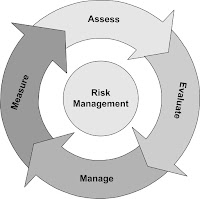Overview of Risk Management
As a risk
manager, what is the most concerned? First of all, risks and the
threat of risks must have little impact on the business processes as
possible. This is really our underlying mission.
We want to
achieve for officer of our organization, for executive management,
for stakeholders and shareholders, what we want is to give back to
them, as a risk manager, is an acceptable level of predictability on
the day to day basis. An a level of assurance or reliability, the
threat and attack of our organization and other vulnerabilities are
going to bring it down to our needs or impede the operations of our
business or organization to a point what substantial of loss as seen.
The
process of risk management is often going to be combined with the
Business Impact Analysis (BIA). In other words, how can we do a
relevant risk management program if we don't really understand the
nature and the extent of risks to our information resources, to our
data resources, to our physical and logical resources and the
individual potential impacts on our activities? Without this impact
analysis, we are not going to be able truly manage risks in an
effective way.
The
Business Impact Analysis (BIA) isn't going to be possible without
information asset classification or identify our assets, classify our
assets and setting the value of our assets, and that's really the
main aspects of risk management and risk
assessment. If our company can't do a full BIA, we can do
another kind of less desirable option that it's called Business
Dependency Evaluation (BDE) which basically determines overall macro
criticality and sensitivity of our organization information
resources.
The result
of this would drive management to weigh the risk exposure with the
costs to mitigate those risks as well as all of the financial,
personal and time overhead it takes to implement countermeasures and
controls in the organization.
Now just
other disciplines that relate to information security. They are that
risk assessment can be quantitative or qualitative. If it's
quantitative basically means we got a mathematical formula involved,
for example ALE, which is the Annual Loss Expectancy, that would be
the value of an asset multiply by exposure factor multiply by the
annualized rate of occurrence. On the other hand, a qualitative risk
assessment is going to be a little more hypothetical. This is based
on human judgement, intuitions and the experience of the people who
assess the risk.
Of course,
from all of this, several positive outcomes should result that we'll
see in next posts.
Best regards my friend
and remember, if you have any question, go
ahead!!










Commentaires
Enregistrer un commentaire